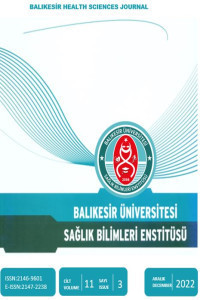Gebelikte Bitkisel Ürün Kullanım Durumlarının Belirlenmesi
Gebelik, Bitkisel Ürün, Tamamlayıcı Tıp, Ebelik, Hemşirelik
Determination of Herbal Product Usage Situations in Pregnancy
Pregnancy, Herbal Product, Complementary Medicine, Midwifery, Nursing.,
___
- Abdollahi, F., Khani, S., & Yazdani Charati, J. (2018). Prevalence and related factors to herbal medicines use among pregnant females. Jundishapur Journal of Natural Pharmaceutical Products, 13(3): e13785. doi: 10.5812/jjnpp.13785.
- Ahmed, M., Hwang, J. H., Hasan, M. A., & Han, D. (2018). Herbal medicine use by pregnant women in Bangladesh: a cross-sectional study. BMC Complementary and Alternative Medicine, 18(1), 333. https://doi.org/10.1186/s12906-018-2399-y
- Al Essa, M., Alissa, A., Alanizi, A., Bustami, R., Almogbel, F., Alzuwayed, O., Abo Moti, M., Alsadoun, N., Alshammari, W., Albekairy, A., Al Harbi, S., Alhokail, M., & Gramish, J. (2019). Pregnant women's use and attitude toward herbal, vitamin, and mineral supplements in an academic tertiary care center, Riyadh, Saudi Arabia. Saudi Pharmaceutical Journal : SPJ : The Official Publication of The Saudi Pharmaceutical Society, 27(1), 138–144. https://doi.org/10.1016/j.jsps.2018.09.007
- Belayneh, Y. M., Yoseph, T., & Ahmed, S. (2022). A cross-sectional study of herbal medicine use and contributing factors among pregnant women on antenatal care follow-up at Dessie Referral Hospital, Northeast Ethiopia. BMC Complementary Medicine and Therapies, 22(1), 146. https://doi.org/10.1186/s12906-022-03628-8
- Belica, A. L., Ćetković, N. B., Milić, N. B., & Milošević, N. P. (2017). Herbal therapy in pregnancy-what to expect when you expect? Natural Product Communications. https://doi.org/10.1177/1934578X1701201236
- Eid, A. M., & Jaradat, N. (2020). Public knowledge, attitude, and practice on herbal remedies used during pregnancy and lactation in West Bank Palestine. Frontiers in Pharmacology, 11, 46. https://doi.org/10.3389/fphar.2020.00046
- Emiru, Y. K., Adamu, B. A., Erara, M., Chanie, T., & Gurmu, A. E. (2021). Complementary and alternative medicine use in a pregnant population, Northwest Ethiopia. International Journal of Reproductive Medicine, 8829313. https://doi.org/10.1155/2021/8829313
- Ersanlı Kaya, C. & Aydın Berktaş, Ö. (2019). Gebelikte kullanılan bitkisel ürünler, kullanım sıklığı ve etkileyen faktörler. UMYOS’2019 (Sempozyum Kitabı Cilt 2). Sinop. 11-13 Haziran, 546-550.
- Illamola, S. M., Amaeze, O.U., Krepkova, L. V., Birnbaum, A. K., Karanam, A., Job, K. M., Bortnikova, V.V., Sherwin, C.M.T., & Enioutina, E. Y. (2020). Use of herbal medicine by pregnant women: What physicians need to know. Frontiers in Pharmacology, Jan 9 (10), 1483. doi: 10.3389/fphar.2019.01483.
- Kennedy, D.A., Lupattelli, A., Koren, G., & Nordeng, H. (2016). Safety classification of herbal medicines used in pregnancy in a multinational study. BMC Complementary and Alternative Medicine, 16: 102. doi: 10.1186/s12906-016-1079-z.
- Kıssal, A., Güner, Ü. Ç., & Ertürk, D. B. (2017). Use of herbal product among pregnant women in Turkey. Complementary Therapies in Medicine, 30, 54-60.
- McLay, J. S., Pallivalappila, A. R., Shetty, A., Pande, B., Al Hail, M., & Stewart, D. (2016). 'Asking the right question'. a comparison of two approaches to gathering data on 'herbals' use in survey based studies. PLoS One, 11(2):e0150140. doi: 10.1371/journal.pone.0150140. PMID: 26914792; PMCID: PMC4767213.
- Mekuria, A. B., Erku, D. A., Gebresillassie, B. M., Birru, E. M., Tizazu, B., & Ahmedin, A. (2017). Prevalence and associated factors of herbal medicine use among pregnant women on antenatal care follow-up at University of Gondar referral and teaching hospital, Ethiopia: a cross-sectional study. BMC Complementary and Alternative Medicine, 17(1), 86. https://doi.org/10.1186/s12906-017-1608-4
- Nordeng, H., & Havnen G. C. (2004). Use of herbal drugs in pregnancy: a survey among 400 Norwegian women. Pharmacoepidemiology and Drug Safety, 13, 371-380.
- Nyeko, R., Tumwesigye, N. M., & Halage, A. A. (2016). Prevalence and factors associated with use of herbal medicines during pregnancy among women attending postnatal clinics in Gulu district, Northern Uganda. BMC Pregnancy and Childbirth, 16(1), 296. https://doi.org/10.1186/s12884-016-1095-5
- Peprah, P., Agyemang-Duah, W., Arthur-Holmes, F., Budu, H. I., Abalo, E. M., Okwei, R., & Nyonyo, J. (2019). 'We are nothing without herbs': a story of herbal remedies use during pregnancy in rural Ghana. BMC Complementary and Alternative Medicine, 19(1), 65. https://doi.org/10.1186/s12906-019-2476-x)
- Sarecka-Hujar, B., & Szulc-Musioł, B. (2022). Herbal medicines-are they effective and safe during pregnancy? Pharmaceutics, 14(1), 171. https://doi.org/10.3390/pharmaceutics14010171
- Wake, G. E., & Fitie, G. W. (2022). Magnitude and determinant factors of herbal medicine utilization among mothers attending their antenatal care at public health ınstitutions in Debre Berhan Town, Ethiopia. Frontiers in Public Health, 10, 883053. https://doi.org/10.3389/fpubh.2022.883053
- ISSN: 2146-9601
- Yayın Aralığı: Yılda 3 Sayı
- Başlangıç: 2012
- Yayıncı: Balıkesir Üniversitesi
Elnaz KARAMELİKLİ, Vusale AZİZ, Reyhan AYDIN DOĞAN
Dental Kaygı ve Ağız Hijyeni Farkındalığı Arasındaki İlişkinin Belirlenmesi
Musa Kazım ÜÇÜNCÜ, Sevda ÖZEL YILDIZ, Haşmet ULUKAPI
H. Sevilay BAHADIR, Elif Ulku DEMİR SERAN
Fatma Nur DUMAN, Zehra GÖLBAŞI, Ayten ŞENTÜRK ERENEL
Servis Sorumlu Hemşirelerine Verilen Eğitiminin Yeterlilik Algılarına Etkisi: Yarı-Deneysel Çalışma
COVID-19 Pandemisinin Ortodontik Tedavi Gören Hastaların Kaygı Düzeyine Etkisi
